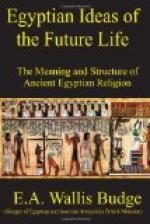In the above extract, it will be noticed that Amen is called the “One of One,” or the “One One,” a title which has been explained as having no reference whatever to the unity of God as understood in modern times: but unless these words are intended to express the idea of unity, what is their meaning? It is also said that he is “without second,” and thus there is no doubt whatever that when the Egyptians declared their god to be One, and without a second, they meant precisely what the Hebrews and Arabs meant when they declared their God to be One. [Footnote: See Deut., vi. 4; and Koran, chapter cxii.] Such a God was an entirely different Being from the personifications of the powers of nature and the existences which, for want of a better name, have been called “gods.”
But, besides R[=a], there existed in very early times a god called HORUS, whose symbol was the hawk, which, it seems, was the first living thing worshipped by the Egyptians; Horus was the Sun-god, like R[=a], and in later times was confounded with Horus the son of Isis. The chief forms of Horus given in the texts are: (1) HERU-UR (Aroueris), (2) HERU-MERTI, (3) HERU-NUB, (4) HERU-KHENT-KHAT, (5) HERU-KHENT-AN-MAA, (6) HERU-KHUTI, (7) HERU-SAM-TAUI, (8) HERU-HEKENNU, (9) HERU-BEHUTET. Connected with one of the forms of Horus, originally, were the four gods of the cardinal points, or the “four, spirits of Horus,” who supported heaven at its four corners; their names were HAPI, TUAMUTEE, AMSET, and QEBHSENNUF, and they represented the north, east, south, and west respectively. The intestines of the dead were embalmed and placed in four jars, each being under the protection, of one of these four gods. Other important gods of the dead are: (1) ANUBIS, the son of R[=a] or Osiris, who presided over the abode of the dead, and with AP-UAT shared the dominion of the “funeral mountain”; the symbol of each of these gods is a jackal. (2) HU and SA, the children of Temu, or R[=a], who appear in the boat of the sun at the creation, and later in the Judgment Scene. (3) The goddess MA[=A]T, who was associated with Thoth, Ptah, and Khnemu in the work of creation; the name means “straight,” hence what is right, true, truth, real, genuine, upright, righteous, just, steadfast, unalterable, and the like. (4) The goddess HET-HERT (Hathor), i.e., the “house of Horus,” which was that part of the sky where the sun rose and set. The sycamore tree was sacred to her, and the deceased prays to be fed by her with celestial food from out of it (5) The goddess MEH-URT, who represented that portion of the sky in which the sun takes his daily course; here it was, according to the view held at one period at least, that the judgment of the deceased was supposed to take place. (6) NEITH, the mother of SEBEK, who was also a goddess of the eastern portion of the sky. (7) SEKHET and BAST, who are represented with the heads of a lion and a cat, and who were symbols of the destroying, scorching power of the sun, and of




